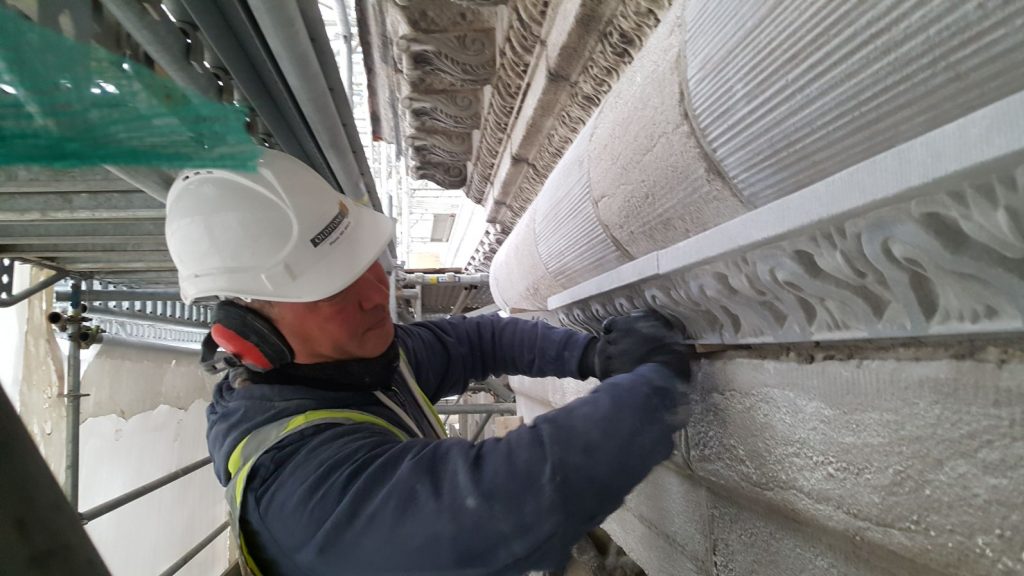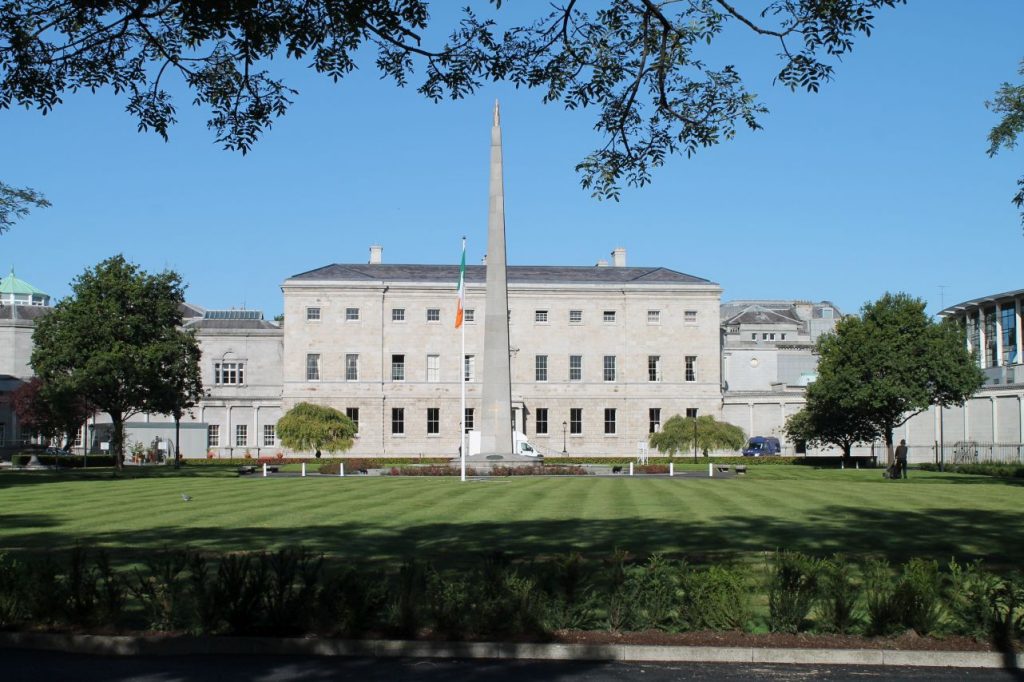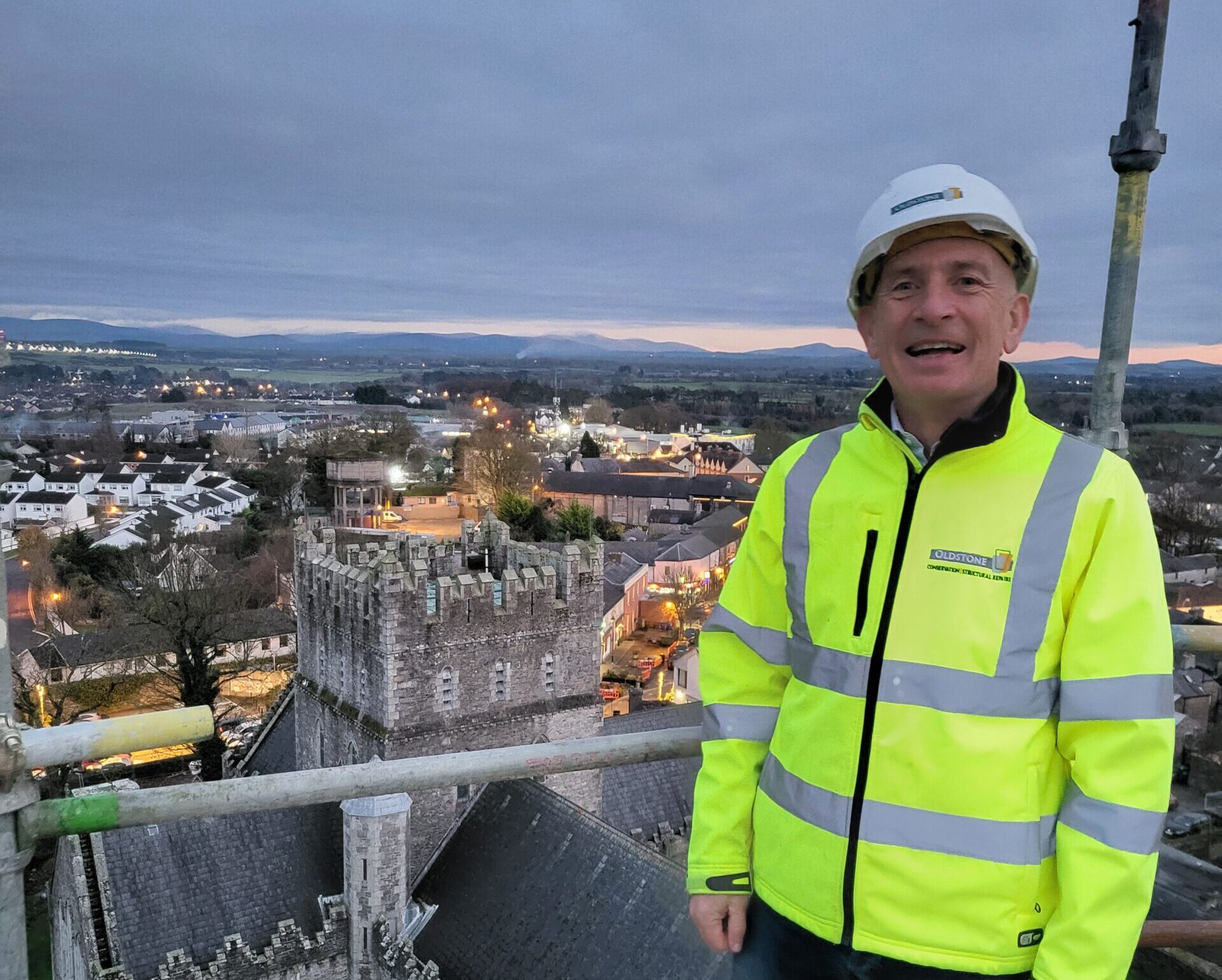Jimmy O’Friel, the new Chairman of the Board at the Register of Heritage Contractors, brings a wealth of experience from the civil engineering and construction realms.
His journey into conservation commenced about 15 or 16 years ago, venturing into the field and managing a conservation company until 2010.
“In 2010, we took the leap and established Oldstone Conservation,” he says, illustrating the challenges and gradual growth inherent to a budding enterprise. The nature of conservation work demands a proven track record, earned through hands-on experience.
“Like any other young business it took a number of years to get established. Building conservation is an area where you really have to earn your stripes, you have to build up your experience and develop a track record of responsible conservation. Clients want to be assured, that they can trust you, to work on the protected structures.”

Working on Leinster House
Oldstone Conservation initially specialised in working with stone, brick and render. However, the company has expanded its scope in recent years, delving into larger projects and assuming comprehensive contracts within the conservation domain.
This evolution signifies a journey from specialised work to undertaking holistic conservation projects.
Notably, their involvement in the works at Leinster House, under Duggan Brothers as the main contractors, showcases the calibre of their projects.
“The big projects are fantastic. They’re highly challenging,” Jimmy says, highlighting the allure of such endeavours.
However, what truly captivates the team isn’t solely the grand undertakings.
“Sometimes, it’s the smaller projects that catch your eye,” he says. “It’s a privilege to work on these sites, to be trusted with preserving their historical significance,” he adds, emphasising the intrinsic value of contributing to the preservation of history.
Working on such projects offers not just access to remarkable buildings but a profound connection with their historical significance.
Being involved in conservation projects requires a particular mindset, a detail-oriented approach and a deep appreciation for history.
“It’s much more personal and timeconsuming,” he says. “You have to have a passion for it and appreciate the building’s history to find fulfilment in it. This specialised nature of conservation work means it’s not a field suited for everyone. It either sparks an interest in you or not. It’s not for everybody.”
He adds: “A lot of the people involved within this sector have a genuine passion and interest in heritage and a great pride in working with these types of buildings.”
He notes an intriguing trend among tradespeople – an evolution of perspective with experience. “Younger tradespeople often aim for ambitious large-scale projects and high productivity, while older ones tend to develop a greater appreciation for conservation work.”
Recruitment of skilled tradespeople, especially those with years of conservation experience, presents a significant challenge.
“We face a shortage of experienced workers in this sector,” he says. “While international recruitment is an option, the housing crisis becomes a major hurdle in accommodating these recruits.”

Leinster House
The inability to provide suitable housing for recruited talent limits the industry’s capacity to bring in skilled individuals from abroad. As a result, there’s an increasing emphasis on internal skill development.
“Without a dedicated conservation centre in the country, training and upskilling our existing workforce become more challenging,” he says, underscoring the need for local skill development initiatives within the field of conservation.
Joining the register is an important step for members to demonstrate their commitment and competency in delivering conservation projects as Jimmy explains the thorough process that undergoes any application. It demonstrates the mark of excellence being a member confers.
Prospective members must present case studies showcasing their experience working on conservation buildings. These case studies need validation from a conservation architect who can attest to the applicant’s involvement and expertise.
“The vetting process involves submitting these applications to the board for assessment,” he says in which the applications are thoroughly reviewed, focusing on the displayed experience in conservation projects.
Upon successfully being admitted to the register, it serves as a testament to expertise. “It adds credibility as an independent body has validated their experience in the field,” he says, emphasising the importance of the register in acknowledging and affirming the prowess of its members.

Heritage contractors at work
As is appropriate for the chair of the Heritage Board when asked of the future Jimmy first stresses the importance of recognising the past, expressing profound respect for Michael O’Sullivan, the former chair of the board who dedicated over two decades to the role.
“It’s a tough act to follow,” he says of the immense contribution made by Michael during his tenure. “His service to the CIF and his continuous promotion of the Register of Heritage Contractors over those 20 years is incredibly commendable.”
For Jimmy O’Friel, it’s about carrying forward this legacy, continuing the efforts to promote the register and emphasising the importance of heritage within the construction industry.
He aims to build on the groundwork laid by his predecessor, raising awareness and encouraging more individuals to engage with heritage work.
“In essence, it’s about nurturing and advancing this sector,” he emphasises, highlighting the ongoing commitment needed to improve and develop the heritage industry for the benefit of the construction community.








